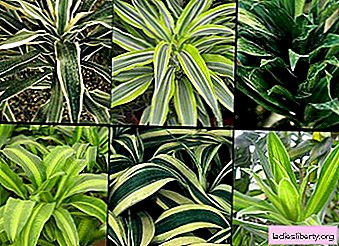
This flower belongs to the most spectacular decorative and deciduous plants of the dracen family. Most of its species (about 150 in total) are of tropical origin, growing in tropical and subtropical Africa and on the islands of Southeast Asia.
There is an old Indian legend about its origin. According to her, once on the island of Socotra, located in the Arabian Sea, there lived a bloodthirsty dragon who attacked elephants and drank their blood. One of the elephants began to defend himself, and, falling on the dragon, crushed him. In a place that was irrigated with the blood of a dragon and an elephant, trees grew up, which were given the name dragon, or dracaena (in Greek, this word means "female dragon").
The most common are dracaena fringed, or marginata (Dracaena marginata). It has a tree-like trunk reaching a height of 3 m and crowned with a bunch of long narrow leaves that look like a disheveled hairstyle. Growing, the leaves fall off, and a characteristic pattern of scars appears on the trunk.
Well-known flower growers and bent dracaena, or reflex (Dracaena reflexa). This plant has a weak stem that branches almost from the root. It got its name because of elongated bright green leaves tilted down, decorated with yellow longitudinal stripes.
Very interesting Dracaena Godsefa (Dracaena Godseffiana), which is very different from other species. It has oval dark green, pointed leaves at the ends, collected in a bush on which there are golden or cream spots. Therefore, the people this flower was called the spotted, or golden dracaena.
Dracaena fragrant (Dracaena fragans) is one of the largest representatives of the variegated species. It can reach a height of 6 m! Its curved hanging leaves have a length of up to 80 cm and a width of about 3 cm. It is called fragrant because of the white or yellow flowers, which have a strong smell. However, in indoor conditions such blooming can not be seen often.
Dracaena deremskaya (Dracaena deremensis) is also a large specimen, reaching a height of about 3 m. Its thick tree-like trunk is covered with dark green leaves having a length of up to 50 cm and a width of up to 5 cm. The leaves of some forms of this species are decorated with longitudinal white and yellow stripes. In nature, flowering with bright red flowers, having an unpleasant odor, occurs, but in indoor conditions this plant blooms extremely rarely.
Dracaena - growing and care
This plant is very unpretentious in care, however, it all depends on the species. The most undemanding are dragon dracaena and Godsef dracaena, which is why they can often be found in residential premises, offices and various institutions.
The plant feels best at moderate temperatures - in the summer from 20 ° C to 25 ° C, in the winter from 12 ° C to 15 ° C. Choosing a place for him, you need to remember that these representatives of the flora are very sick from drafts.
This flower is very photophilous, however, does not tolerate direct sunlight. That is, the eastern or western side would be the ideal place for him. Species with dark leaves need less light than variegated plants, which lose their color due to a lack of light. This plant feels pretty well under artificial lighting.
Watering for different species should be different. So, fragrant dracaena is very hygrophilous; for it, drying an earthen coma can end in death. Although pouring it is unacceptable. The earth should always be a little wet, that's enough. In summer, the flower is watered every day, and in winter, watering should be reduced.
Humidity is also determined by the type of plant. Dry air will not harm unpretentious forms, but the rest need frequent spraying. This must be done in the summer heat and in winter, if the room has central heating. He loves the plant when it is washed in the shower or at least wipe the leaves from dust.
This flower responds very well to the application of special complex fertilizers for indoor plants, with which it should be fed once every two weeks from April to August.
Dracaena - transplantation and reproduction
The plant is transplanted every two years, in the spring season. For transplantation, take a mixture of heavy turf and sheet land with rotted manure or greenhouse land with sand. The location of the roots of this flower is the topsoil, so you should take care of a large drainage.
For propagation, apical cuttings, pieces of the trunk having a length of at least 10 cm, layering are used. Cutting off the top of the plant and putting it in a jar of water, after three months you can get a shoot with roots suitable for transplanting into a pot (however, pieces of charcoal must be added to the jar). On the mother plant, where the tip was cut, new shoots will appear from the side buds.
Dracaena - Diseases and Pests
Proper care of this flower virtually eliminates its disease. Inadequate watering, he always responds with dry leaf edges, and when exposed to leaves of direct sunlight, light dry spots appear on them. Then you need to adjust the watering and spraying of the plant, and place it in a comfortable environment.
The pests of the plant include the scabbard (its appearance can be recognized by brown plaques on the underside of the leaf) and the spider mite (it parasitizes on the bottom half of the leaf, resulting in yellow spots on the top).
To remove the scab, soapy water is used, then the plant is treated with an insecticide. In case of severe pest damage, the treatment is carried out within a few weeks.
An insecticide spray is also used to remove the spider mite. However, regular spraying with water and wiping dracaena leaves with a wet cloth is an excellent prevention of plant damage by pests and diseases.











